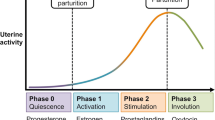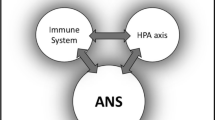Abstract
Several neuroendocrine factors have been shown to influence the muscle phenotype. Various physiological reports have suggested the role of adrenergic nervous system for cardiac myosin heavy chain (MHC) expression. We have used cultured fetal rat heart myocytes to investigate the role of cAMP on the α- and (β-MHC gene expression. In low density cultures, addition of 1 mM 8 Br CAMP resulted in up regulation of α-MHC and down regulation of β-MHC mRNA. This antithetic effect of cAMP depends on the basal expression of both MHC transcripts. In transient transfection analysis employing a series of α-MHC gene promoter/reporter constructs, we identified a 13 by E-box M-CAT hybrid motif (EM element) which conferred a basal muscle specific and cAMP- inducible expression of the α-MHC gene. Data obtained from the mobility gel-shift analysis indicated that one of the factor(s) binding to the EM element is related to troponin T M-CAT binding factor (TEF-1). To test whether the protein binding to this sequence could be a substrate for cAMP-dependent phosphorylation, the cardiac nuclear proteins were preincubated in a kinase reaction buffer either with a catalytic subunit of PKA (CatPKA) or with cAMP, and binding activity of proteins to the EM element was evaluated by mobility gel shift assay. In a concentration dependent manner, a twofold increase in the intensity of the retarded band was observed. Furthermore, at 100 units of CatPKA, an additional band of faster mobility was observed which was not present either when phosphorylated nuclear extract was incubated with alkaline phosphatase or when ATP was absent in kinase reaction buffer. These results strongly suggest that factor(s) binding to the EM element is a substrate for cAMP dependent phosphorylation.
Similar content being viewed by others
References
Bandman E: Contractile protein isoforms in muscle development. Dev Biol 154: 273–283, 1992
Shimizu N, Camoretti-Mercada B, Jakovcic S, Zak R: RNA transcription in heart muscle. In: H.A. Fozzard, E. Haber, R.B. Jennings, A.M. Katz, H.E. Morgan (eds). The Heart and Cardiovascular System, 2nd ed., Raven Press, Ltd, New York, 1992, pp 1525–1538
Bugaisky LB, Gupta M, Gupta MP, Zak R: In: Cellular and molecular mechanisms of cardiac hypertrophy, In: H.A. Fozzard, E. Haber, R.B. Jennings, A.M. Katz, H.E. Morgan (eds). The Heart and Cardiovascular System, 2nd edn, Raven Press, New York, 1992, pp 1621–1640
Emerson CP, Bernstein SL Molecular genetics of myosin. Annu Rev Biochem 56: 695–726, 1987
Mahdavi V, Strehler EE, Periasamy M, Wieczovek DF, Izumo S, Nadal-Ginard B: Cardiac myosin heavy chain genes are organized in tandem. Proc Natl Acad Sci USA 81: 2626–2630, 1984
Chizzonite RA, Zak R: Regulation of myosin isoenzyme composition in fetal and neonatal rat ventricle by endogeneous thyroid hormones. J Biol Chem 259: 12628–12632, 1984
Swynghedauw B: Developmental and functional adaptation of con-contractile proteins in cardiac and skeletal muscle. Physiol Rev 66: 710–771, 1986
Pagani ED, Julian FJ: Rabbit papillary muscle myosin isozymes and the velocity of papillary muscle shortening. Circ Res 54: 586–594, 1984
Lyons GE, Schiaffino S, Sasson D, Barton P, Buckingham M: Developmental regulation of myosin gene expression in mouse cardiac muscle. J Cell Biol 111: 2427–2436, 1990
Lompre AM, Mercadier JG, Wisnewsky C, Bouveret P, Pantaloni D, Albis D, Schwartz K: Species and age-dependent changes in the relative amounts of cardiac myosin isoenzymes in mammals. Dev Biol 84: 286–290, 1981
Izumo S, Nadal-Ginard B, Mahdavi V: All members of the MHC multigene family respond to thyroid hormone in a highly tissue-specific manner. Science 231: 597–600, 1986
Izumo S, Mahdavi V: Thyroid hormone receptor a isoforms generated by alternative splicing differentially activate myosin heavy chain gene transcription. Nature 334: 539–542, 1988
Buttrick, PM, Malhotra A, Factor S, Geener D, Scheuer J: Effects of chronic dobutamine administration on hearts of normal and hypertensive rats. Circ Res 63: 173–181, 1988
Dowell RT: Myocardial contractile function and myofibrillar adenosine triphosphatase activity in chemically sympathectomized rats. Circ Res 39: 683–689, 1976
Kawana M, Ischizuka N, Taira A, Kimata S, Hosoda S: Effects of cardiac sympathetic activity on myosin isozymes of rabbit heart. Circulation 80 (Suppl II): 462, 1989
Advani SV, Malhotra A, Liang D, Geener DL, Buttrick PM, Scheuer J: Swimming attenuates the shift in myosin isoenzymes in the rat heterotopic cardiac isograft. Circulation 80 (Suppl II):297, 1989
Winegrad S, McClellan G, Wiesberg A, Lin LE, Weindling S Horowitz A: Beta adrenergic regulation of cardiac myosin. Can J Physiol Pharmacol 65: 606–609, 1986
Karin M: Complexities of gene regulation by CAMP. Trends Genet 5: 65–66, 1989
Roesler WJ, Vanderbark GR, Hanson RW: Cyclic AMP and the induction of eukaryotic gene transcription. J Biol Chem 263: 9063–9066, 1988
Nag AC, Cheng M: Expression of myosin isoenzymes in cardiac muscle cells in culture. Biochem J 221: 21–26, 1984
Clark WA, Chizzonite RA, Everett AW Rabinowitz M, Zak R: Species correlations between cardiac isomyosins: A comparison of electrophoretic and immunological properties. J Biol Chem 257: 5449–5454, 1982
Chirgwin JM, Przybyla AE, MacDonald RJ, Rutter WJ: Isolation of biologically active ribonucleic acid from sources enriched in ribonuclease. Biochemistry 18: 5294–5298, 1979
Higuchi R: Recombinant PCR. In: M.A. Iunis, D.H. Gelfand, J.J. Sninsky, T.J. White (eds). PCR Protocols: A Guide to Methods and Applications, Academic Press, New York, pp 177–183, 1990
Olsen DB, Eckstein F: High-efficiency oligonucleotide-directed plasmid mutagenesis. Proc Natl Acad Sci USA 87: 1451–1455, 1990
Dignam JD, Lebovitz RM, Roeder RG: Accurate transcription initiation by RNA polymerase II in a soluble extract from isolated mammalian nuclei. Nucleic Acid Res 11: 1475–1489, 1983
Montminy MR, Sevarino KA, Wagner JA, Mandel G, Goodman RH: Identification of a cyclic-AMP-responsive element within the rat somatostatin gene. Proc Natl Acad Sci 83: 6682–6686, 1986
Moss JB, McQuinn TC, Schwartz RJ: The avian cardiac a-actin promoter is regulated through a pair of complex elements composed of E boxes and serum response elements that bind both positive and negative acting factors. J Biol Chem 269: 12731–12740, 1994
Winter B, Braun T, Arnold HH: cAMP-dependent protein kinase represses myogenic differentiation and the activity of the muscle-specific helix-loop-helix transcription factors myf-5 and myoD. J Biol Chem 268: 9869–9878, 1993
Ostman-Smith I: Prevention of exercise-induced cardiac hypertrophy in rats by chemical sympathectomy. Neurosci 1: 497–507, 1976
Womble JR, Larson DF, Copeland JG, Brown BR, Maddox MK, Russel DH: Adrenal medulla denervation prevents stress-induced epinephrine plasma elevation and cardiac hypertrophy. Life Sci 27: 2417–2420, 1980
Sartorelli V, Kedes L: Myocardial activation of the human cardiac aactin promoter by helix-loop-helix proteins. Proc Natl Acad Sci USA 89: 4047–4051, 1992
Mar JH, Ordahl CP: M-CAT binding factor, a novel transcription factor governing muscle-specific transcription. Mol Cell Biol 12: 619–630, 1990
Gupta MP, Gupta M, Zak R: An E-box/M-CAT hybrid motif and cognate binding protein(s) regulate the basal muscle-specific and cAMPinducible expression of the rat cardiac a-myosin heavy chain gene. J Biol Chem 269: 29677–29687, 1994
Shimizu N, Smith G, Izumo S: Both a ubiquitous factor mTEF-1 and a distinct muscle-specific factor bind to the M-CAT motif of the myosin heavy chain S gene. Nucleic Acid Res 21: 4103–4110, 1993
Ishiji T, Lack MJ, Parkkinen S, Anderson RD, Hangen TH, Crippe TP, Man JH, Davidson I, Chambon P, Turek LP: Transcription enhancer factor (TEF-1) and its cell-specific co-activator activates human papillomavirus E6 and E7 oncogene transcription in keratinocytes and cervical carcinoma. EMBO J 11: 2271–2281, 1992
Baeuerle PA, Baltimore D: IkB: A specific inhibitor of the NFkB transcription factor. Science 242: 540–546, 1988
Morikoshi M, Kai T, Kin Y-S, Green MR, Roeder: Transcription factor ATF interacts with the TATA factor to facilitate establishment of a preinitiation complex. Cell 54: 1033–1042, 1988
Corsi PS, Sisson JC, Verma EM: Trascriptional auto-regulation of the proto-oncogene fos. Nature 334: 314–319, 1988
Pagani ED, Julian FJ: Rabbit papillary muscle myosin isozymes and the velocity of papillary muscle shortening. Circ Res 54: 586–594, 1984
Pope B, Hoh JFY, Weeds A: The ATPasc activities of rat cardiac myosin isoenzymes. FEBS Lett 118: 205–208, 1980
Winegrad S, McClellan G, Tucker M, Lin L-E: Cyclic AMP regulates myosin isoenzymes in mammalian cardiac muscle. J Gen Physiol 81: 749–765, 1983
Jacob R: Chronic reactions of myocardium at the myofibrillar level. Reflections on ‘adaptation’ and ‘disease’ based on the biology of long-term cardiac overload. In: Jacob R et al. (ed.). Cardiac Adaptation of Hemodynamic Overload, Training and Stress. Steinkopff Verlag, Darmstadt pp 3–24, 1983
Author information
Authors and Affiliations
Rights and permissions
About this article
Cite this article
Gupta, M.P., Gupta, M., Dizon, E. et al. Sympathetic control of cardiac myosin heavy chain gene expression. Mol Cell Biochem 157, 117–124 (1996). https://doi.org/10.1007/BF00227889
Issue Date:
DOI: https://doi.org/10.1007/BF00227889




